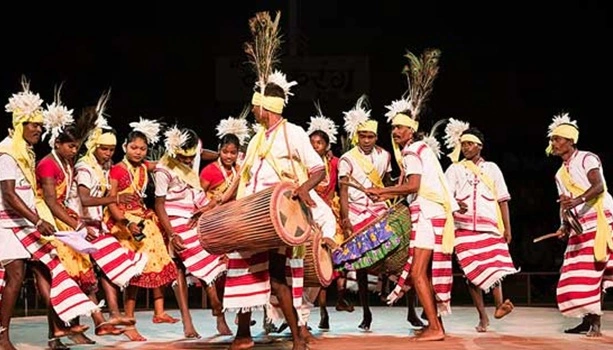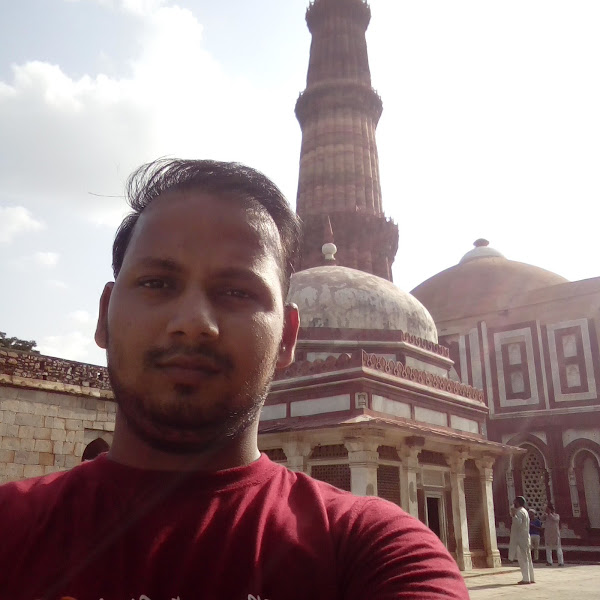Jharkhand, known as the “Land of Forests”, is a state in eastern India rich in tribal heritage, folklore, and vibrant cultural traditions. The state is home to 32 recognized tribes, each contributing to its diverse cultural landscape. Folk dances in Jharkhand are not merely artistic performances—they are a reflection of tribal life, agricultural practices, spiritual beliefs, and social celebrations.
From the energetic Chhau to the rhythmic Jhumar, Jharkhand’s dances are performed during festivals, harvests, weddings, and community events, often accompanied by traditional music, colorful costumes, and symbolic props. These dances are living testaments to the cultural identity and social harmony of the state.

Major Traditional and Folk Dances of Jharkhand
| Dance Name | Type | Region / Community | Short Description |
| Chhau Dance | Martial / Folk | Saraikela, Mayurbhanj (bordering Jharkhand-Odisha) | Masked dance depicting mythological stories, heroism, and battles. |
| Jhumar | Folk | Chotanagpur Plateau | Performed during harvests; rhythmic dance with circular formations. |
| Paika Dance | Folk / Martial | Tribal Areas | War dance performed by men to showcase valor and martial skills. |
| Fagua Dance | Festival / Folk | Tribal Communities | Performed during Holi festival with singing and playful movements. |
| Mundari Dance | Tribal / Folk | Munda Tribe | Expresses tribal folklore, daily life, and social events. |
| Karma Dance | Ritual / Folk | Tribal Regions | Celebrates nature worship and the Karma festival with vibrant group dances. |
| Panch Pargana Dance | Folk | North Jharkhand | Performed during festivals and weddings; involves synchronized group movements. |
| Santali Dance | Tribal / Folk | Santhal Tribe | Performed during harvests and festivals; includes singing and drumming. |
| Chhau Mahotsav | Folk / Cultural | Saraikela and Ranchi | Special performance during festivals showcasing Chhau variants. |
| Domkach Dance | Folk / Wedding Dance | Tribal and Rural Areas | Performed by women during weddings; rhythmic clapping and singing. |
Detailed Explanation of Major Dances
1. Chhau Dance – Martial and Masked Performance
- Origin: Saraikela and Mayurbhanj regions; evolved from tribal martial traditions.
- Cultural Significance: Combines martial arts, storytelling, and religious symbolism, depicting stories from Ramayana, Mahabharata, and local legends.
- Costumes: Elaborate masks for characters, colorful attire representing gods, demons, and heroes.
- Musical Instruments: Dhol, shehnai, dhamsa, and cymbals.
- Occasions: Chhau Mahotsav, festivals, and cultural programs.
- Image Suggestion: Masked dancers performing battle scenes in open courtyards with traditional instruments.
2. Jhumar – Rhythmic Harvest Dance
- Origin: Chotanagpur Plateau tribal communities.
- Cultural Significance: Celebrates harvest, joy, and community bonding; performed in circular formations.
- Costumes: Traditional sarees for women; men wear dhotis and turbans.
- Musical Instruments: Dhol, mandar, nagara, and folk singing.
- Occasions: Harvest season, local festivals, and weddings.
- Image Suggestion: Villagers dancing in circles during harvest celebrations with colorful attire.
3. Paika Dance – Martial Tribal Dance
- Origin: Tribal regions of Jharkhand.
- Cultural Significance: Represents valor, courage, and martial skills; performed by men in traditional armed attire.
- Costumes: Warrior outfits with swords, shields, and headgear.
- Musical Instruments: Drums, horns, and folk percussion.
- Occasions: Festivals, village fairs, and special tribal events.
- Image Suggestion: Male performers showcasing martial steps with swords in tribal attire.
4. Fagua Dance – Festival Celebration
- Origin: Tribal communities across Jharkhand.
- Cultural Significance: Performed during Holi (Fagua festival) to celebrate spring, love, and playful social interaction.
- Costumes: Bright and colorful traditional attire; often smeared with colors during the festival.
- Musical Instruments: Dhol, mandar, and folk singing.
- Occasions: Fagua (Holi) festival.
- Image Suggestion: Groups dancing with colorful powders during Holi celebrations.
5. Mundari Dance – Tribal Storytelling
- Origin: Munda tribe of Jharkhand.
- Cultural Significance: Expresses tribal folklore, daily life, and village stories; promotes social unity.
- Costumes: Traditional tribal attire with ornaments and feathered headgear.
- Musical Instruments: Drums, cymbals, flutes, and folk singing.
- Occasions: Village festivals, weddings, and tribal gatherings.
- Image Suggestion: Mundari tribal performers dancing in open village spaces.
6. Karma Dance – Nature Worship
- Origin: Various tribal regions of Jharkhand.
- Cultural Significance: Performed to worship nature and celebrate Karma festival; symbolizes prosperity and communal harmony.
- Costumes: Colorful sarees and turbans; ornaments for men and women.
- Musical Instruments: Dhol, mandar, shehnai, and cymbals.
- Occasions: Karma festival, harvest celebrations, and local fairs.
- Image Suggestion: Tribal groups dancing under trees with drums and folk songs.
7. Panch Pargana Dance – Group Festival Dance
- Origin: North Jharkhand regions.
- Cultural Significance: Celebrates festivals, weddings, and community gatherings; emphasizes coordinated group movements.
- Costumes: Traditional attire of respective communities; women in sarees, men in dhotis and turbans.
- Musical Instruments: Dhol, nagara, flutes, and folk singing.
- Occasions: Festivals, marriages, and village fairs.
- Image Suggestion: Group of dancers performing synchronized steps in a festival setting.
8. Santali Dance – Harvest and Festival Dance
- Origin: Santhal tribe of Jharkhand.
- Cultural Significance: Performed during harvests and festivals; involves energetic footwork, singing, and drumming.
- Costumes: Traditional tribal attire with feathered headgear and ornaments.
- Musical Instruments: Dhol, mandar, banam, and cymbals.
- Occasions: Sohrai, harvest festivals, and tribal fairs.
- Image Suggestion: Santhal tribal dancers performing in a circle with drums.
9. Chhau Mahotsav – Festival Performance
- Origin: Saraikela and Ranchi regions.
- Cultural Significance: Special Chhau dance festival showcasing various Chhau forms and characters.
- Costumes: Elaborate masks, colorful robes, and props representing heroes and demons.
- Musical Instruments: Dhol, shehnai, cymbals, and horns.
- Occasions: Chhau Mahotsav, cultural programs, and national festivals.
- Image Suggestion: Festival stage with masked Chhau dancers performing battle sequences.
10. Domkach Dance – Wedding Ritual Dance
- Origin: Tribal and rural areas of Jharkhand.
- Cultural Significance: Performed by women during weddings; involves clapping, singing, and rhythmic steps.
- Costumes: Traditional sarees with jewelry and flowers.
- Musical Instruments: Dhol, manjira, and folk singing.
- Occasions: Weddings and pre-wedding celebrations.
- Image Suggestion: Women performing Domkach steps with joyful expressions during wedding ceremonies.
FAQs
Q1. Which is the most famous dance of Jharkhand?
👉 Chhau Dance is the most famous, performed with masks and elaborate movements depicting mythological stories.
Q2. How many folk dances does Jharkhand have?
👉 Jharkhand has more than 10 major traditional and folk dances, each reflecting tribal, martial, and festive traditions.
Q3. Are these dances performed by men or women?
👉 Ritual dances like Chhau and Paika are performed by men, while Fagua, Domkach, and Jhumar involve both men and women.
Q4. Which dances are performed during festivals?
👉 Chhau, Fagua, Karma, Santali, and Jhumar dances are commonly performed during festivals, harvests, and community celebrations.
Conclusion
The traditional and folk dances of Jharkhand are a vibrant reflection of tribal heritage, social customs, and agrarian life. From the heroic and masked Chhau dance to the rhythmic Jhumar and Domkach dances, each form preserves stories, rituals, and communal values.
These dances connect communities, celebrate nature and life, and sustain cultural traditions, making them an essential part of Jharkhand’s cultural identity. The colorful attire, expressive movements, and resonant folk music together illustrate the spirit, resilience, and joy of Jharkhand’s people.

Hello, I’m Kapil Kumar, a seasoned SEO expert and blogger at WinnersList.in. My mission is to spotlight exceptional individuals and organizations across various domains. Through curated lists, profiles, and inspiring stories, I aim to celebrate outstanding achievements and inspire the next generation of champions. Join me in this journey.
